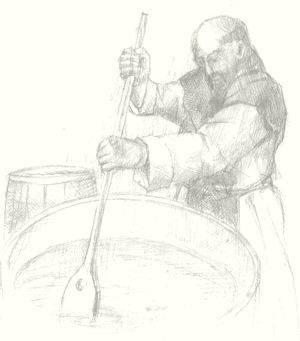The Cistercians were active in all branches of husbandry.  Most of the villages that came into being from the farmsteads of the huge estate lying on a total area of 275 km2 have still been in existence. The cultivation of cereals was based on the three-course rotation. Bread made from wheat was considered too luxurious, therefore mostly barley and rye were grown in addition to the leguminous plants. Locally bred cattle gave the indispensable draught animals, while horses were used for carting. The breeding of pigs and sheep was very important for food, but poultry was also kept. Milk was processed for making cheese. Wax and honey were gained from the apiaries – honey was used not only as a substitute for sugar, but also for making mead. Salt supply was also available as King Béla III provided Szentgotthárd with twenty thousand salt-cubes a year. In the workshops monks and worker brothers, such as master builders, wood carvers, smiths, carpenters, wainwrights and tanners were working. Each workshop had its head and only he was allowed to speak during performing work. Regarding mills, the biggest one was built in the vicinity of the abbey, in the area where the scythe factory is located today. There was also a bakery workshop that provided bread also for the neighbouring farmsteads.
Most of the villages that came into being from the farmsteads of the huge estate lying on a total area of 275 km2 have still been in existence. The cultivation of cereals was based on the three-course rotation. Bread made from wheat was considered too luxurious, therefore mostly barley and rye were grown in addition to the leguminous plants. Locally bred cattle gave the indispensable draught animals, while horses were used for carting. The breeding of pigs and sheep was very important for food, but poultry was also kept. Milk was processed for making cheese. Wax and honey were gained from the apiaries – honey was used not only as a substitute for sugar, but also for making mead. Salt supply was also available as King Béla III provided Szentgotthárd with twenty thousand salt-cubes a year. In the workshops monks and worker brothers, such as master builders, wood carvers, smiths, carpenters, wainwrights and tanners were working. Each workshop had its head and only he was allowed to speak during performing work. Regarding mills, the biggest one was built in the vicinity of the abbey, in the area where the scythe factory is located today. There was also a bakery workshop that provided bread also for the neighbouring farmsteads.
{quiz id=16}
